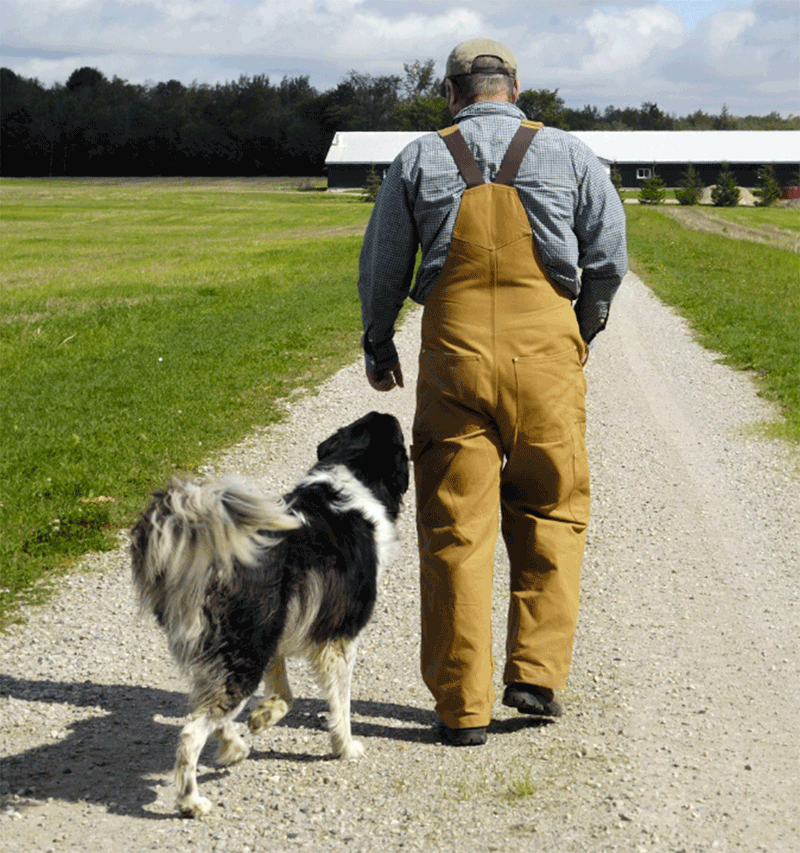A fresh focus on cover crops
WATER QUALITY AND THE BOTTOM LINE
AGRICULTURE IS ALWAYS changing. Naturally, we farmers closely monitor and adjust to the ebb and flow of market conditions, weather, and new developments in technology and biology.
PHOTO: INSPECTING THE FARM.

Ontario grain farming has unique qualities, but it is always good to look afield to see if trends developing elsewhere should be considered. One such development is the rapidly growing use of cover crops in some North American regions.
Here is some historical perspective. Prior to the late 1940s and early 50s, cover crops were used routinely as ‘green manure’. Crops like clovers, winter peas, and certain grasses were planted in late summer or early fall to cover the soil over winter. Some warmer weather cover crops survived the winter (were not winterkilled). They were grazed or left to grow until just before they produced seed and then ploughed under. Their decomposition in the soil provided added organic matter and fertility for crops planted in spring.
World War II fueled a huge increase in North American chemical production. Following the war, those same factories made synthetic fertilizers cheap and widely available. Farmers saw yields jump when these new fertilizers were applied, and the boom was on. Chemicals ruled, new equipment became the rock stars of farming, and cover crops were largely forgotten.
Now, after more than a half century of high intensity cultivation, some soils are largely depleted of their natural, healthy biology. It is interesting that scientists are continuously discovering the secrets of a robust and balanced ecosystem of microbes, fungi and other tiny life forms interacting with plant roots in synergistic ways.
Soil health is a highly complex topic. But as a farmer, I need to keep it simple. I have been a no-till farmer in Lancaster County, Pennsylvania, for over 30 years. Cover crops are essential to my operation because they bring me profits, not expenses. My organic matter has increased from around two percent to nearly five percent — proof of a system investment that has paid off during extreme weather events that we have from time to time.
When I want to check the health of my soil, I think “earthworms.” To me, they are like the “canary in the coal mine,” an indicator of conditions. I have a habit of inspecting my fields constantly, but not just by looking at the surface.
Along with my dog Dixie, my shovel is a constant companion on these walks. When I see lots of earthworms in my first shovelful of soil, I feel confident that the microscopic biology in my soil is in pretty good condition. They are at the top of the soil’s microscopic food chain, so to speak. When you see a robust worm population, things in the soil are probably in pretty good shape. Sometimes I say to Dixie, “Hey girl, just look at those worms!” Her tail generally wags in approval.
We use chemicals on our farm. We are not unrealistic when it comes to their benefits, which are many when used properly. Like with most things, sustainable results are all about balance.
Cover crops help gather up excess and left-over soil nutrients after harvest, holding them over winter, and releasing them in spring. By using cover crops farmers keep more of the fertilizer they already paid for. The soil cover, a protection of a bare soil surface, improves water infiltration and reduces water and wind erosion. And soil biology has a chance to recover toward its more natural state.
So, cover crops help farmers, his downstream neighbours, and the entire environment at the same time. That is why I travel widely to tell my story to fellow farmers, and to share what I have found about the benefits of cover crops and how to use them.
I have proven that on my operation, cover crops pay. They make a significant contribution to my bottom line with reduced costs and often with stronger yields — depending on conditions. They pay very well when properly managed, but they are not a magic bullet. In fact, I think of cover crops the same way I do my corn, my soybeans, my wheat and any other crop I grow for cash. To me, cover crops are that important. My neighbours and those downstream seem to think so too.
Steve Groff farms 220 acres in Lancaster County, Pennsylvania. The terrain is hilly with mild slopes, and the native soil is a clay loam that includes plenty of rocks. Groff helped develop the Tillage Radish®, and is a co-founder of Cover Crop Solutions, supplier of a range of cover crops and mixes. Some of Groff’s research can be downloaded at CoverCropSolutions.com > Resources or TillageRadish.com > Resources. •

















